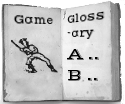Base (Prisoner's Base)
| Game | Base (Prisoner's Base) |
|---|---|
| Game Family | Hook-em-snivy |
| Location | |
| Regions | US, Britain |
| Eras | 1700s, 1800s, Pre-1700, Predecessor |
| Invented | No |
| Tags | |
| Description | Sometimes seen as a name for base ball. While some references to “base” most likely denote Prisoner’s Base (a team form of tag similar in nature to modern Capture the Flag and, perhaps, today’s Laser Tag), others denote a ball game. David Block reports that the earliest clear appearance of “base” as a ball game is from New England in 1831, and that his source groups base with cricket and cat as young men’s ballgames. |
| Sources | Thomas Altherr, "Base Is Not Always Baseball: Prisoner's Base From the 13th to the 20th Centuries." Base Ball, Volune 3, number 1 (Spring 2009), pp 67-79. See also 19cBB posting, October 17, 2007; Our Game log, July 16, 2022 |
| Source Image | [[Image:|left|thumb]] |
| Comment | See also 1852.17 -- A work by Charles Dickens titled "The Child's Story" (1852) in which Dickens writes: "They were active ... at cricket and all games of ball; the prisoners base, hare and hounds, follow up leader, and more sports than I can think of."
There's a reference to a game of "prison base" in The Chester (UK) Chronicle, June 23, 1815.
A description of Prisoner's base can be found in the Salisbury, NC The Old North State, Jan. 28, 1870.
See also Bancroft, "Games for the Playground" (1922) p. 156:
"PRISONER'S BASE Prisoner's Base is one of the most popular games for both boys and girls who are beginning to care for team organization, and is capital for adults. It gives opportunity for vigorous exercise for all of the players, for the use of much judgment, prowess, and daring, and for simple team or cooperative work. The game is found under many different forms. Several, which offer marked or typical differences, each possessing distinct playing values, are given here. These differences are in (i) the arrangement of the ground, and (2) the rules governing the players and game. The differences in the grounds may be classed as follows: — I. The entire playground divided in two divisions, one belonging to each party, each division having a small pen for prisoners at the rear. (Diagram I.) n. The main part of playground neutral territory, with home goals for the opposing parties at opposite ends, with prisons in, near, or attached to them. (Diagrams II, V.) III. The main part of playground neutral territory, with home goab for both parties at the same end, attached or separate, and prisons at the opposite end, either (i) on the same side of the ground as the home goal, or (a) on the enemy's side of the ground. (Diagrams III-IV.) The rules for play for the second and third types of ground are fundamentally the same, though differing in details, and they differ from those for Diagram I. The playing qualities of the games for the last three diagrams, however, are very distinct because of the different methods of the enemies* approach to each other (which make differences in the risk of **dares")» and because of the differing risks in rescuing prisoners and taking the enem3r's goal by entry. It has seemed best to make a selection of the typical forms, and leave the feader of games free to choose his own. The first form is the simplest for beginners and younger players, and makes a good introduction to the game for such players." [ba] |
| Query | Edit with form to add a query |
| Has Supplemental Text |
Comments
<comments voting="Plus" />
